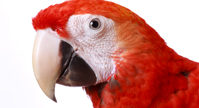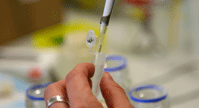Aspergillus Detection for Birds
ANIMAL GENETICS OFFERS PCR AND CULTURE TESTING FOR ASPERGILLUS IN BIRDS.
Description:
 The genus Aspergillus includes a variety of related fungi which cause aspergillosis. An important member of this genera is Aspergillus fumigatus. This fungus produces endotoxins which are generally responsible for the disease known as aspergillosis. Aspergillus species are common in the environment. Spores often become airborne in dry, windy weather spreading from one location to another. Spores can enter an individual and develop in the respiratory system (lungs, eyes, and ears). Sick Building Syndrome is a condition caused by continuous fungal growth in areas of buildings and ventilation systems. Growth leads to the release of more spores. This can potentially lead to large-scale respiratory infections and distress associated with aspergillosis.
The genus Aspergillus includes a variety of related fungi which cause aspergillosis. An important member of this genera is Aspergillus fumigatus. This fungus produces endotoxins which are generally responsible for the disease known as aspergillosis. Aspergillus species are common in the environment. Spores often become airborne in dry, windy weather spreading from one location to another. Spores can enter an individual and develop in the respiratory system (lungs, eyes, and ears). Sick Building Syndrome is a condition caused by continuous fungal growth in areas of buildings and ventilation systems. Growth leads to the release of more spores. This can potentially lead to large-scale respiratory infections and distress associated with aspergillosis.
Aspergillosis can be fatal, especially for those with immunodeficiency. This opportunistic pathogen is common among domesticated and caged birds.
Penicillium notatum and the antibiotic revolution:
Not all fungi are problematic. In fact some are vital in fighting numerous bacterial infections. In 1941 Albert Alexander had an infection at the corner of his mouth caused by the bacteria Staphylococci and Streptococci. Over time the infection spread to the rest of his face, eyes, and lungs. At the time, two scientists (Howard Florey and Earnest Chain) had just begun purifying a substance produced by the fungus Penicillium notatum that killed bacteria and was discovered by Alexander Fleming. Albert Alexander's doctor, Charles Fletcher, knew that Florey and Chain were looking to test this drug on a human volunteer, and so in February of 1941 Albert Alexander became the first human treated with penicillin. Within 24 hours of his initial treatment his temperature dropped, his appetite returned and his infection began to heal.
Transmission:
Transmission of Aspergillus species occurs via inhalation of conidia (fungal spores) from contaminated feed, fecal material, and soil. The spores are often present in the environment and healthy, unstressed birds are generally resistant to even high levels of spores. However, young and old birds, birds on antibiotics and those birds whose immune systems are suppressed by surgery, reproduction, environmental changes, capture, shipping or age are frequently infected.
Aspergillus can also infect the developing embryo by penetrating the egg while the embryo is developing. Infected eggs may develop a slightly greenish tint when candled. Well-developed lesions may appear on infected embryos after they hatch.
Symptoms:
Symptoms range from respiratory distress, gasping, accelerated breathing, voice changes, abnormal droppings, emaciation, regurgitation, poor appetite, diarrhoea, anorexia, gout, increased thirst, nasal discharge, conjunctivitis, dyspnea, neuromuscular disease, somnolence, lesions (yellow or gray nodules and/or plaques in the lungs, air sacs, or trachea; less often in the peritoneal cavity, liver or other sites).
Diagnosis:
Tentative diagnosis can be made with clinical signs along with the absence of bacterial infection. A blood test showing an elevation in white blood cell count, mild anemia and an elevation in the monocytes also supports this diagnosis. X-rays can be taken on any suspect patient. A radiograph can reveal densities or nodules consistent with aspergillomas. Samples of the fungus can also be taken and cultured in specially-prepared culture media. Caution: Apergillus is a common environmental contaminant.
PCR assays are used to identify the presence of Aspergillus.
Sample Type:
When testing individual birds, a throat culture is required as well as a vent/cloacal swab if possible. If the sample tests positive and clinical signs are positive, the bird should be placed in quarantine and aggressive treatment should begin immediately.
Environmental testing using swabs of aviaries, countertops, fans, air-filters, nest-boxes, etc. is extremely effective in determining the presence of Aspergillus in the environment. Remember that Aspergillus is found naturally in certain environments without causing any harm.
Limitations:
As with any genetic test, new mutations may occur in the organism's genome that could affect the assay. Therefore, it may be difficult to detect new or different subtypes. Sample collection plays a pivotal part in the overall accuracy of the test so please use caution and follow the instructions carefully.
Treatment:
Antifungal treatments: Amphotericin, Flucytosine, Fluconazole & Itraconazole. Immunostimulants. Surgery may be required with certain localized Aspergillomas. Consult your verterinarian about specific treatment options.
Submit a Sample for Testing:
To submit a sample download a test submission form at Downloads
Cost per sample is $24.50. Please see our fee schedules below for bulk and combination rates.










